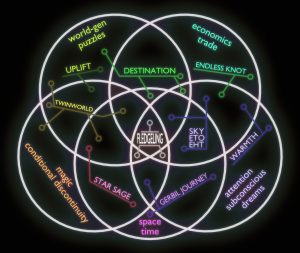You may have noticed that I have talked about several different games here. I am attempting to zero in on the concepts that I am exploring; To approach Fledgeling from a variety of angles. So, quite recently, it occurred that I thought to map out these aspects, and see where each sub-game might lie in relation to the whole.
Here I have made a Venn diagram of the five major topics which interest me in game design.
- Unconventional world-gen and puzzles (logic, discovery, and traversal)
- Economics and trade
- Magic (that is, systematized conditional discontinuities)
- Space (variety pack) and time
- Attention, subconscious, and dreams
I’ve already introduced the ideas of Uplift, Warmth, Gerbil Journey, To See the Sky, and Twinworld (Zarth and Tumult), so perhaps you can see how they fit into this diagram. I’ll write up overviews of Star Sage, Destination, and Endless Knot at some point, but the idea at hand is to examine the unified model of the elements which compose Fledgeling, the various angles of approach, and how the experience might flow from one into another seamlessly.
For example, one might be playing a character in TwinWorld, and decide they would rather play as the Tumult itself, toying with gyres and subduction and such. This is very Uplift-style play, and it wouldn’t be difficult, once you had characterized your tumult playstyle, to transfer that behavior to a completely different scenario, in a world generated with no regard for the Twinworld structures. After playing around with a half dozen of these worlds, you might want to begin to evaluate your impact on inhabitants in these various worlds, and the means they use to deal with the havoc you’ve been wreaking. And now we’re sliding into Destination style puzzles (played from the “other side” of the conventional approach, but that’s fine)
This diagram really excites me! By modulating the inclusion of the various elements, any of these sub-games could be part, or the entirety, of a Fledgeling game or scenario. The long-dreamed structure is starting to take shape.
While I was working on this post, my daughter walked by, looked intently at the diagram for several seconds, and then declared decisively “That looks like madness!”
I’m glad you noticed.

